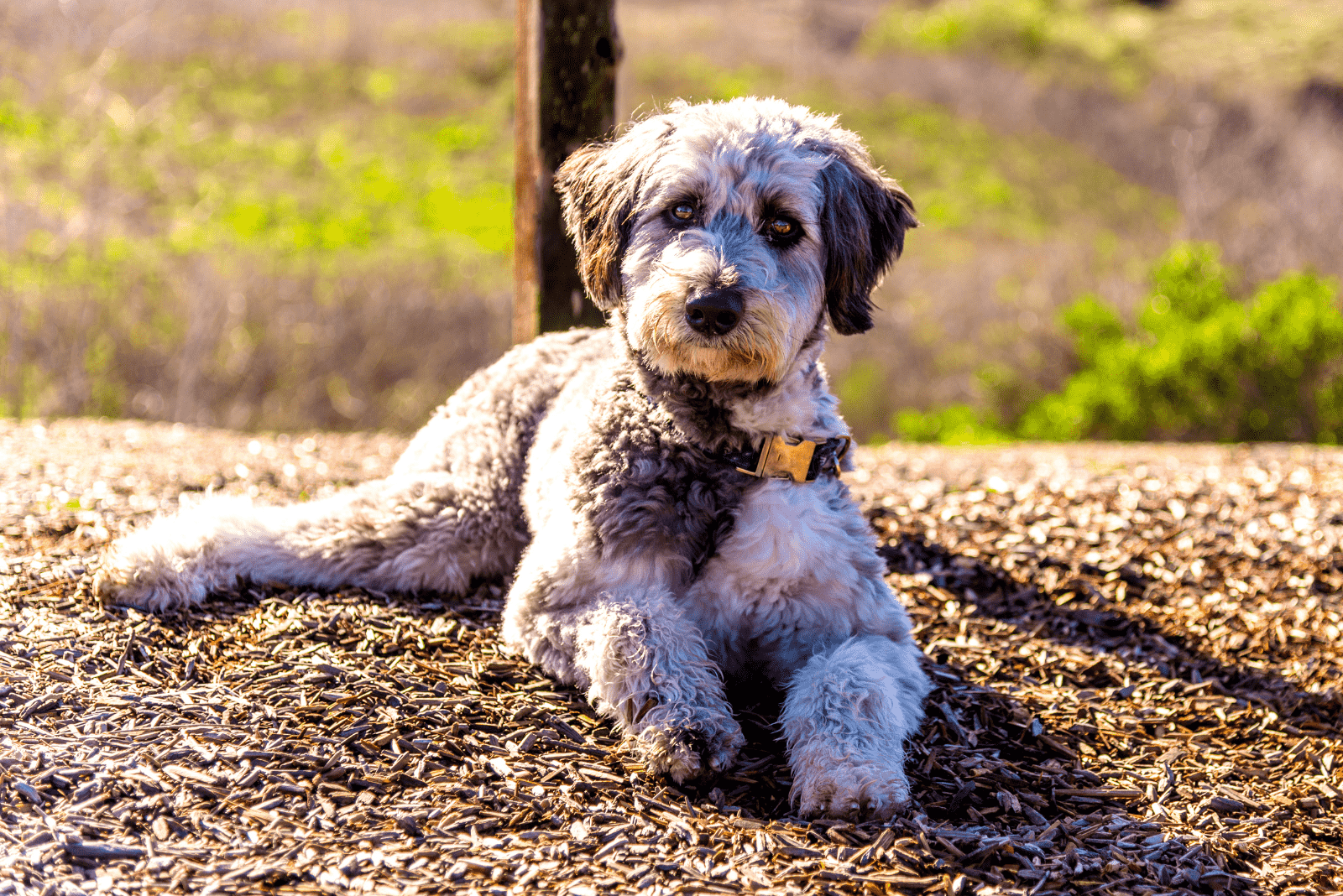Aussiedoodles are usually considered a medium-sized dog breed, even though they can come in various sizes. This can sometimes make it difficult for their owners to keep track of their growth as it can be tough to know exactly what to expect.
You don’t have to worry when it comes to tracking the growth of your Aussiedoodle as this article is written to help you. We’ve made a handy and easy-to-understand Aussiedoodle growth chart for your use.
Aussiedoodles were originally created in the mid-20th century by mixing two very distinct breeds — the Australian Shepherd and the Poodle. The result was a designer-breed dog that could not be officially recognized and registered by the American Kennel Club despite both of its ancestors being purebred.
The same thing happens with some other Poodle crossbreeds; for example, Labradoodles, Goldendoodles, and Maltipoos. However, it hardly affects their popularity at all, given how well-liked they are, especially as family dogs and companions.
The noticeable difference in size between Australian Shepherds and Poodles makes it confusing for some Aussiedoodle owners when trying to figure out how big their pet can get. So, what’s the deal with that? Let’s get deeper into it and take a look at our Aussiedoodle growth chart.
Aussiedoodle Growth Chart
Obviously, the most important factor that affects a dog’s size is its age. From their birth and up until they reach full maturity, puppies will usually grow and develop at a much higher rate, after which they will stop and settle on a defined size.
However, the rate of growth isn’t the same for every Aussiedoodle puppy. In fact, it can sometimes be difficult to determine whether your Aussiedoodle is the right weight for its age or if it is developing the way that it should.
Therefore, a growth chart is necessary. With the chart below, you will have some good points of reference and a great overall guide to Aussiedoodle weight by age. Just find your dog’s age on the table and check what the desired weight is supposed to be.
With that, you’ll know whether your pup needs to put on some pounds or maybe hit the doggy gym.
Aussiedoodle Weight Chart By Age
[table id=584 /]
Adult Aussiedoodle Size Chart
[table id=655 /]
Do Aussiedoodles Come In Different Sizes?
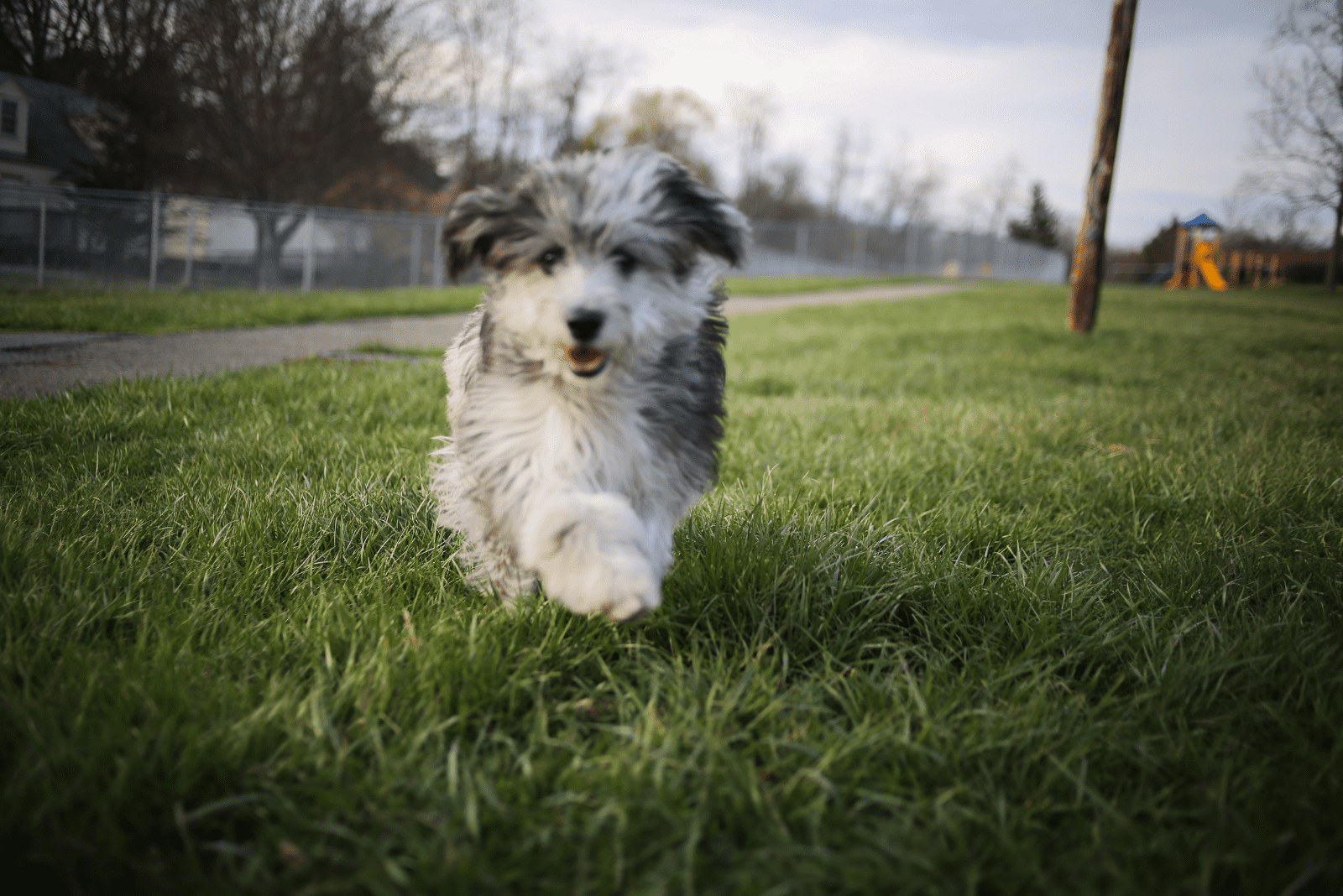
As you might have noticed from the charts, there are three different sizes of Aussiedoodles.
Aside from the variations in their physical size and weight, there are also some other differences between the three types. Let’s go through each of them individually and see what their specifics are.
Toy Aussiedoodle
The Toy Aussiedoodle is the smallest variant of the breed, and it was created when breeders combined the Australian Shepherd with the Toy Poodle.
Depending on the individual dog, Toy Aussiedoodles will generally reach a fully mature size of between the ages of 7.5 and 11 months. They max out at about 10 inches (25 cm for our metric system-using friends) in height, and have a recommended weight of 10 to 15 pounds (4.5 to 6.8 kg).
Like any extra-small dog, these pups are very appropriate for people who live in a small apartment in a big city as they don’t typically need a lot of space to move around. You can even carry them around town in your arms or in a bag!
Mini Aussiedoodle
Miniature Aussiedoodles are right in the middle of the three types of this breed when it comes to dimensions, so it’s no wonder why people sometimes refer to them as Medium Aussiedoodles.
They are a crossbreed of a Miniature Australian Shepherd and a Miniature Poodle.
They have a slightly wider range of height and weight than the toy ones do, and they usually take a longer time to reach their adult weight.
As you can see from the chart, they usually stop growing in the 11 to 13-month age range, but their weight can vary anywhere between 15 and 45 pounds (6.8 and 20.4 kg).
In most cases, a Medium Aussiedoodles’ weight is highly dependent on the size of its parents, especially its Poodle parent.
Standard Aussiedoodle
The Standard Aussiedoodle is the largest type in the breed, and judging by the data in the charts, its height and weight can vary wildly. This happens because of a number of different possibilities when it comes to parental influence.
Even though they are a mixed breed of the Standard Australian Shepherd and the Standard Poodle, variations in size and weight are possible. Standard Aussiedoodles can be anywhere between 15 and 25 inches (38.1 and 63.5 cm) tall at the withers, and weigh in the range of 45 to 70 pounds (20.4 to 31.8 kg).
As you can see, in some cases, they can be quite large dogs… bigger than, for example, Bulldogs. Naturally, they take a bit more time to fully grow into their body. They usually reach their full physical development after their first birthday, sometimes even taking up to 16 months.
As opposed to Toy Aussiedoodles, and even the Mini ones, the Standard type needs much more open space to move around and exercise. They fit better with people with a house and a yard than they do with apartment dwellers.
Aussiedoodle Full Grown
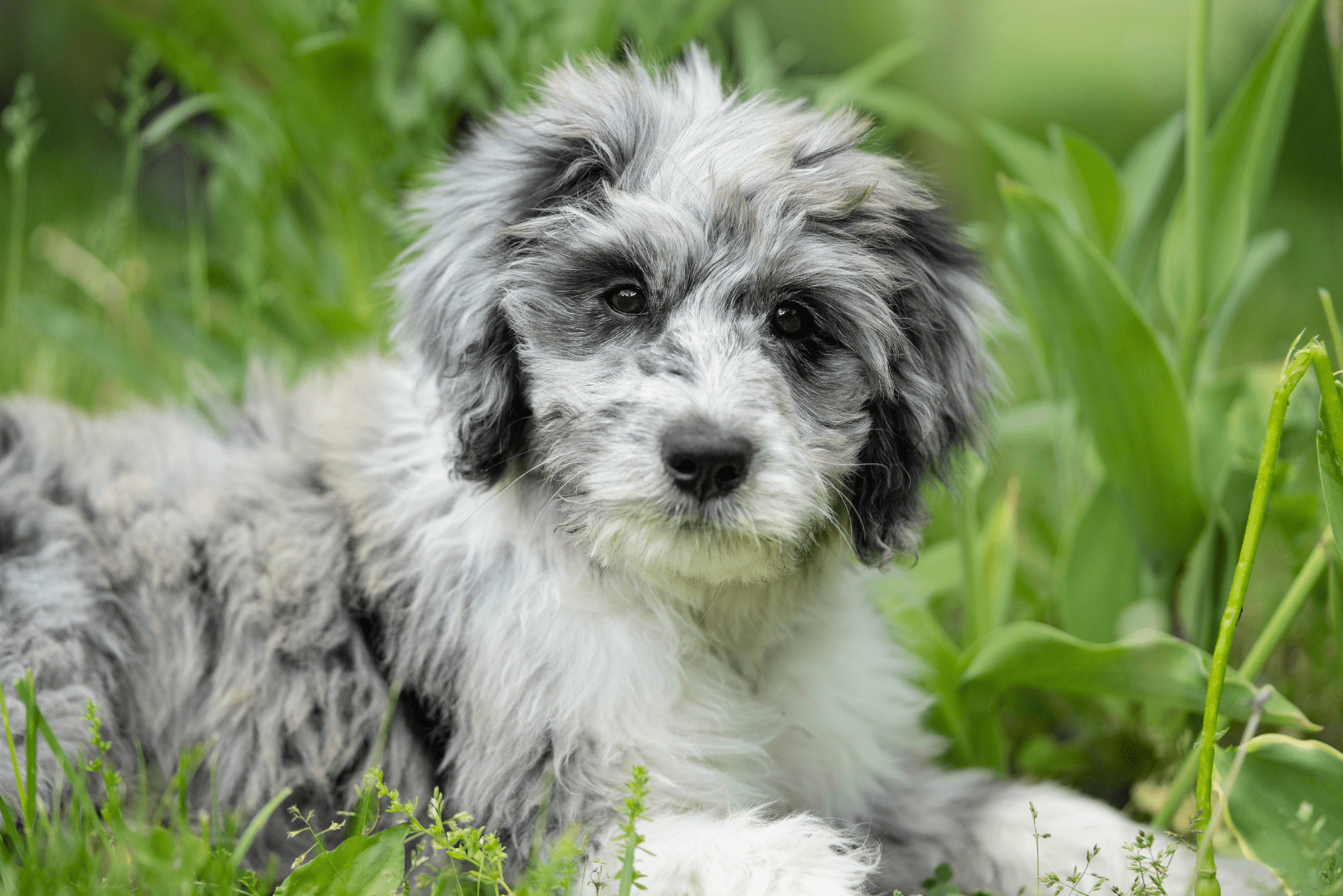
So far, we’ve been able to highlight the differences between the three different types of Aussiedoodles. Now, let’s talk about some of the common occurrences in their development stages.
We have divided their development roughly into six stages so that we can go into more detail beyond the puppy growth chart and describe what exactly is going on with their body in each one.
Under 2 Weeks
During this period, Aussiedoodles are nothing but tiny balls of fur, weighing no more than a couple of pounds.
New puppies are unable to take care of themselves, and are 100% dependent on their mommy and her milk, which literally comprises their entire diet.
2 Weeks — 3 Months
This is the point when a lot of noticeable growth starts occurring. Their muscles start forming, teeth begin coming in, and they slowly start getting weaned off the milk by their mother.
During these weeks, they often double or even triple their entire body weight, and that’s in no small part due to the introduction of puppy food.
3 Months — 6 Months
This stage of development is most notable for teeth development. For most Aussiepoos, teeth will begin to come in within the first couple of months after birth, but by the time they reach six months — their choppers should really be well-formed.
Teeth aren’t the only thing that grows in this period – they also start putting on some serious weight. Toy Aussiedoodles average around seven pounds at this time (which is basically half of their adult weight), and Standard Aussiedoodles can weigh over 40 pounds.
Typically, females tend to be slightly smaller than males.
6 Months — 9 Months
Like most dog breeds, Aussiedoodles experience more changes in the first year of their life than in the entire time afterward.
The period after they reach six months of age is a crucial one because this is the time when the females enter their first heat cycle. However, even though it’s possible for them to get pregnant and give birth, it’s not advised that they do because their development is not fully completed.
In terms of size, the smaller versions of the Aussiedoodle — the Toy and the Mini — will start rounding up nicely and approaching their adult size and shape.
9 Months — 1 Year
This is usually the time when no drastic physical changes occur in the body of an Aussiedoodle. There are some smaller refinements in terms of their shape and dimensions that eventually lead to their final form.
But, the biggest changes happen in their behavior. Mental and emotional maturation take the wheel in this stage as the pups start exploring their surroundings and acting out… like a bunch of teenagers!
Over 1 Year
On average, one-year-old Aussiedoodles are fully-grown adult dogs with all the discernible traits and characteristics.
Their body has been fully fleshed out and developed, they have reached their full-grown size, and they are completely accustomed to it and comfortable in their own skin.
They can continue to develop their personality to a degree, and maybe add some muscle, but naturally,, they are in the final stage of their formation.
How Big Will My Aussiedoodle Get?
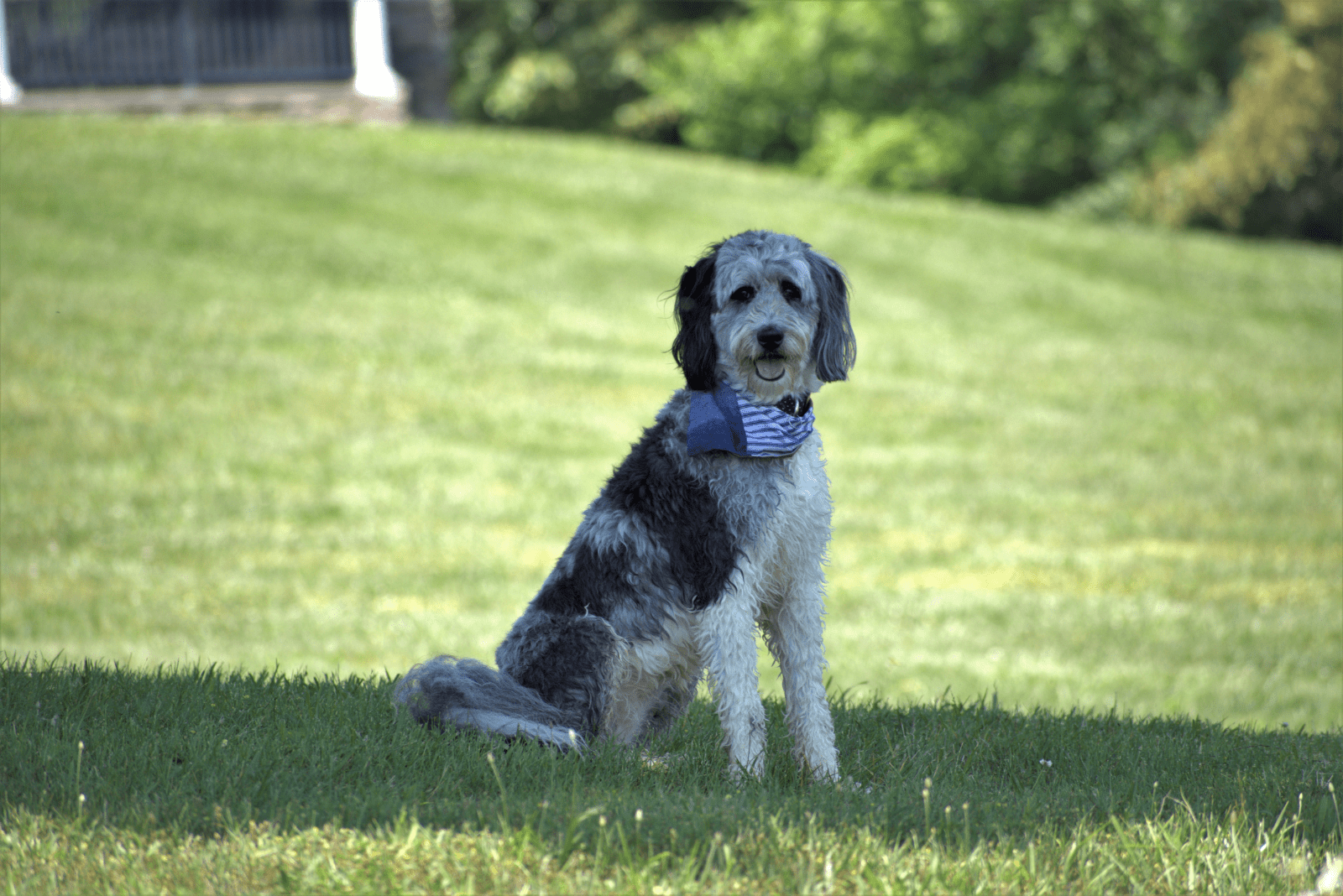
There is a wide range of sizes that an Aussiedoodle can grow into, and it can be tricky to predict. But, there are certain factors that influence their growth that you can use as guidelines.
The biggest influence comes from the breeding process and the Aussiepoo’s parents; however, some of it comes from nature.
Breeding
The growth rate is a hereditary trait, so the size of your Aussiedoodle will be determined by the size of its parents. Generally, a fully grown one will be the average size of the Australian Shepherd parent and the Poodle parent.
Check the Australian Shepherd growth chart to find out more about this dog’s size.
But, not just that… genetic diseases from their parents can also impact their development. For example, Poodles are known for being hypoallergenic, and that often gets passed down to their Aussiedoodle offspring.
In the simplest of terms, if you know your Aussiepoo’s family background, and how big their parents were, there’s a good chance you can guess what they will look like when they’re all grown up.
Diet
This perhaps goes without saying, but Aussiedoodles will only reach a healthy size if they have proper nutrition.
They need all the nutrients, vitamins, and protein that they can get so that their body can grow and develop like it’s supposed to. High-quality dog food is recommended.
In some cases, if you notice that your dog is underweight, that means that it might need supplements.
Supplements are a great way of supporting a dog’s diet, but it would be smart to first talk to a vet and see what their opinions are and what they can recommend.
Weight Gain In Aussiedoodles
Aussiedoodles are one of those breeds that rapidly gain weight, especially if they are overfed and given too many treats. This is another trait that they’ve inherited from their parent breeds as both Australian Shepherds and Poodles can have the same problems.
To combat this, it’s best that you have a strict plan of feeding that you stick to no matter what. Learn about your dog’s exact nutritional needs and develop an individualized diet that will provide it with everything its body needs — but no more than that.
We know how hard it can be to say ‘no’ to those puppy eyes, but you need to stand firm and not give them that extra treat.
In addition to the Aussiedoodle growth chart, look for a feeding chart, and ask your vet for advice before creating a diet plan. This way, you will know you’re on the right track.
Exercise
Exercise provides the necessary physical stimulation that promotes the growth of an Aussiedoodle’s bones and muscles. Even though they aren’t known for requiring a great deal of activity — particularly the toy ones — they still need their fair share, especially during their puppyhood.
The bigger they are, the more exercise they will need, so if you have a standard Aussiedoodle, make sure to take him outside as often as you can.
There is another issue that exercising can solve, and that is the problem of obesity. If your Aussiedoodle becomes overweight, then exercise is the most obvious, effective, and easiest way of getting it back into the correct weight range.
Make the effort to take extra long walks and spend more time playing with them. Aussiedoodles are very social dogs, and they will greatly enjoy spending time with you in addition to all the health benefits it will bring to them.
General Appearance
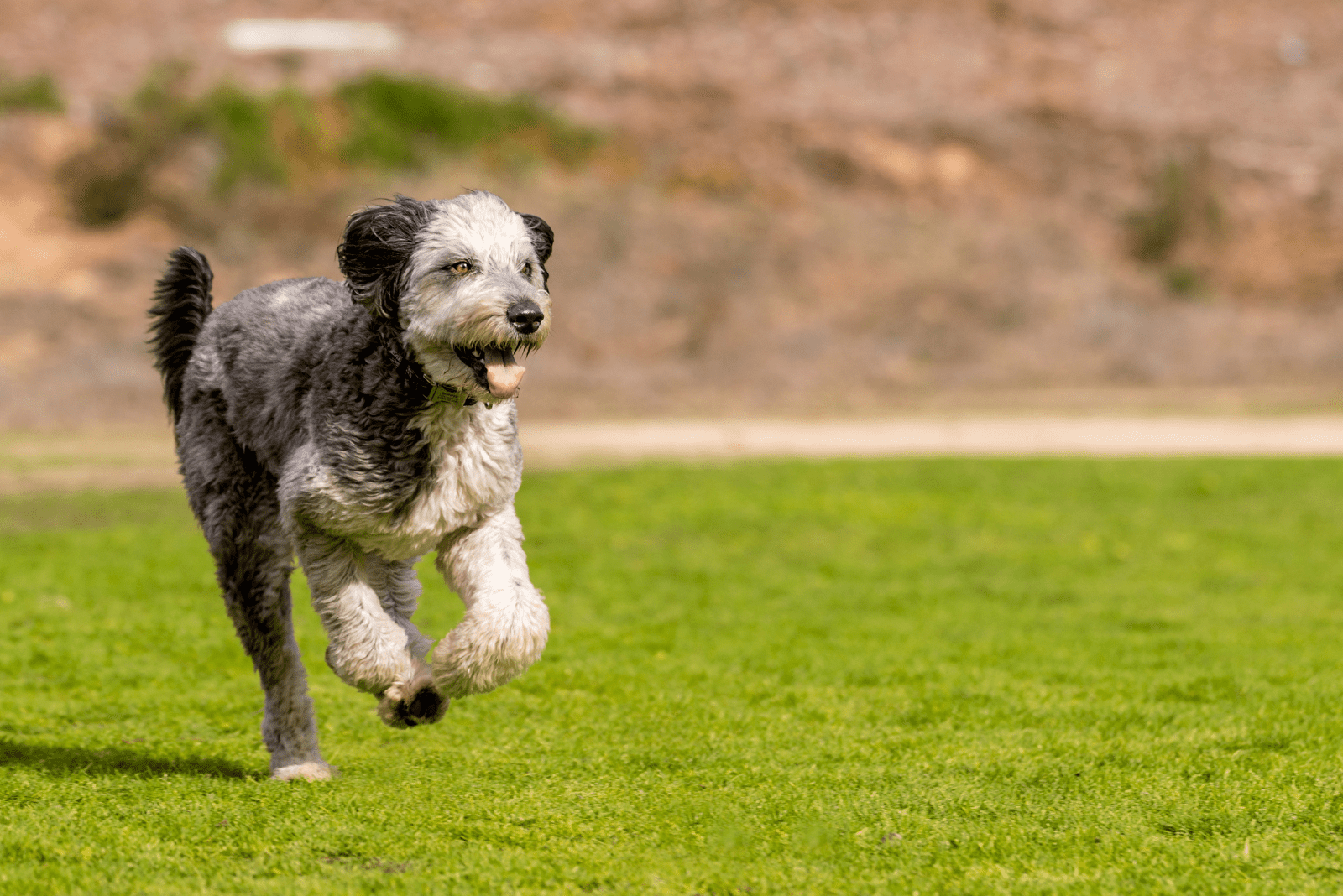
When talking about Aussiedoodles as a breed, there are many traits in their appearance that are common to all three types.
Due to the genes they pick up from Australian Shepherds, they are slightly disproportional, i.e., they are a bit shorter in height than what they should be when compared to their length. Aside from that, they are surprisingly proportionate and well put together for a designer breed.
Their head is squarely built and strong, their shoulders are extended and flat, and their chest is fairly deep and relatively narrow.
Their coat is medium length, often wavy (but it can be straight as well), and it provides them with good protection from the weather, especially rain and wind.
There is also a decently-sized undercoat, but that will largely depend on the climate of the area they’re in. They can sometimes be reminiscent of Cocker Spaniels and other similar breeds.
When it comes to coat color, it comes in a wide variety of shades, and it can have bi-colored, or sometimes tri-colored patterns. Some of the more popular hues are blue merle, red merle, sable, black and red, black and tan, etc.
Their coat is very rarely made up of just one solid color.
Check Also: Australian Shepherd Colors: How Many Shades Are There?
Personality
Bred for companionship, the Aussiepoo has all the personality traits that you would expect in a family dog. Being extremely friendly, cuddly, and playful, they enjoy being around their owner and receiving attention.
Why Do I Need An Aussiedoodle Growth Chart?
Let’s get back to the topic of the Aussiedoodle growth chart. If you’re asking yourself why you would ever need one — the answer is pretty simple.
Due to their vastly unique genetic background, Aussiepoos can come in a number of different sizes. Even if you are an experienced and knowledgeable dog owner, it can be confusing when you try to figure out just how big your dog is supposed to be.
By using the growth chart as a reference, you can always check whether your Aussiedoodle is on the right track in its development, as well as make sure that its weight is under control. Weight fluctuation can often be an issue with designer-breed dogs, and it’s important to stay on top of it.
Essentially, the chart is a sort of puppy weight calculator — a helpful tool that you can use to check if your Aussiepoo is within the normal height and weight parameters for its type and age.
The Final Word
The Aussiedoodle growth chart will be incredibly useful to any Aussiedoodle owner struggling to figure out if their dog is the right size or not.
It can point you in the right direction when it comes to deciding on the amount of exercise as well as food portions, and the number of treats you give to your dog.
In addition to that, all the extra information listed in this article will hopefully provide a lot of insight into this unique breed and help you maintain their best health; thus, allowing them to live their best dog life.
Read Next: • Pomeranian Growth Chart – How Big Can Pomeranians Get?
